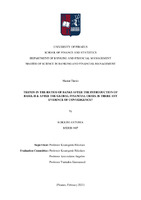| dc.contributor.advisor | Κουρογένης, Νικόλαος | |
| dc.contributor.advisor | Kourogenis, Nikolaos | |
| dc.contributor.author | Κοκκίνη, Αντωνία | |
| dc.contributor.author | Kokkini, Antonia | |
| dc.date.accessioned | 2021-03-29T10:49:35Z | |
| dc.date.available | 2021-03-29T10:49:35Z | |
| dc.date.issued | 2021-02 | |
| dc.identifier.uri | https://dione.lib.unipi.gr/xmlui/handle/unipi/13354 | |
| dc.identifier.uri | http://dx.doi.org/10.26267/unipi_dione/777 | |
| dc.description.abstract | Σε αυτή την μελέτη συζητήσαμε λεπτομερώς τη σημασία και την ανάπτυξη της Βασιλείας, εστιάζοντας στη Βασιλεία II. Κάθε αλλαγή ήταν σε απάντηση σε νέα επενδυτικά προϊόντα που δημιουργήθηκαν με την πάροδο του χρόνου, ή γεγονότα που αποκάλυψαν τις αδυναμίες του προηγούμενου κανονιστικού πλαισίου. Έτσι, με την ευκαιρία της παγκόσμιας χρηματοπιστωτικής κρίσης, εμφανίστηκαν οι κίνδυνοι της αναντιστοιχίας της λήξης και του ασταθούς συνδυασμού χρηματοδότησης στους ισολογισμούς των τραπεζών. Ως αποτέλεσμα, αυτό που διέπει τη ρευστότητα των τραπεζών έχει αλλάξει σε ρυθμιστικό και εποπτικό επίπεδο.
Χρησιμοποιώντας τις τέσσερις μεγαλύτερες τράπεζες όσον αφορά την κεφαλαιοποίηση από τις δύο βασικές χώρες της Ευρωζώνης, τη Γαλλία και τη Γερμανία, και δύο άλλες χώρες από την περιφέρεια, την Ιταλία και την Ισπανία, εκτιμούμε ένα μοντέλο που χρησιμοποιεί δεδομένα πίνακα για τον προσδιορισμό των βασικών μοχλών της κεφαλαιακής επάρκειας. Δεν καταφέραμε να εντοπίσουμε καμία μεταβλητή που επηρεάζει τον δείκτη κεφαλαιακής επάρκειας για ολόκληρη την περίοδο. Καθώς το δείγμα περιέχει τόσο την οικονομική κρίση του 2008 όσο και την ευρωπαϊκή κρίση χρέους, εξετάζουμε την παραπάνω σχέση μετά τη δήλωση του Mario Draghi’s “whatever it takes”. Εκτιμώντας το μοντέλο μας από το 2013 έως το τέλος για να ανιχνεύσουμε την επίδραση της απεριόριστης ποσοτικής χαλάρωσης που δόθηκε στο σύστημα, βρίσκουμε ότι οι λόγοι των συνολικών ιδίων κεφαλαίων και καθαρών δανείων προς το σύνολο των περιουσιακών στοιχείων επηρεάζουν το δείκτη κεφαλαιακής επάρκειας.
Τέλος, λόγω των πακέτων στήριξης και των ενεργειών ενοποίησης των ισολογισμών των τραπεζών, καταλήγουμε στο συμπέρασμα ότι η β - σύγκλιση επιτυγχάνεται για τον λόγο κεφαλαιακής επάρκειας του επιλεγμένου ομίλου τραπεζών. | el |
| dc.format.extent | 57 | el |
| dc.language.iso | en | el |
| dc.publisher | Πανεπιστήμιο Πειραιώς | el |
| dc.rights | Αναφορά Δημιουργού-Μη Εμπορική Χρήση-Όχι Παράγωγα Έργα 3.0 Ελλάδα | * |
| dc.rights.uri | http://creativecommons.org/licenses/by-nc-nd/3.0/gr/ | * |
| dc.title | Trends in the ratios of banks after the introduction of Basel II & after the global financial crisis. Is there any evidence of convergence? | el |
| dc.type | Master Thesis | el |
| dc.contributor.department | Σχολή Χρηματοοικονομικής και Στατιστικής. Τμήμα Χρηματοοικονομικής και Τραπεζικής Διοικητικής | el |
| dc.description.abstractEN | In this study, we have discussed in detail the importance and development of Basel, focusing on Basel II. Each change was in response to new investment products created over time, or events that revealed the weaknesses of the previous regulatory framework. Thus, on the occasion of the global financial crisis, the risks of the mismatch of maturity and the unstable combination of financing in the balance sheets of the banks appeared. As a result, what governs banks' liquidity has changed at a regulatory and supervisory level.
Using the four largest banks in terms of capitalization from the two core countries of the Eurozone, France and Germany, and two other countries from the periphery, Italy and Spain, we estimate a model using panel data to identify the key drivers of the capital adequacy ratio. We were not able to identify any variable affecting the capital adequacy ratio for the whole period. As the sample contains both the financial crisis of 2008 and the European debt crisis, we examine the relationship above in the aftermath of Mario Draghi’s “whatever it takes” statement. Since the statement was in July 26, 2012 and our data are yearly, we estimate our model from 2013 to the end, to detect the influence of the unlimited quantitative easing provided in the system and we conclude that the ratios of total equity and net loans over total assets affect the capital adequacy ratio.
Finally, due to the support packages and the consolidation actions of the banks' balance sheets, we conclude that the β – convergence is achieved for the capital adequacy ratio of the group of banks selected. | el |
| dc.contributor.master | Χρηματοοικονομική και Τραπεζική με κατεύθυνση στην Χρηματοοικονομική και Τραπεζική Διοικητική | el |
| dc.subject.keyword | Basel | el |
| dc.subject.keyword | Supervision | el |
| dc.subject.keyword | Β – convergence | el |
| dc.subject.keyword | Risk management | el |
| dc.subject.keyword | Market risk | el |
| dc.subject.keyword | Liquidity risk | el |
| dc.subject.keyword | Operational risk | el |
| dc.subject.keyword | Capital adequacy | el |
| dc.subject.keyword | Non-performing loans | el |
| dc.subject.keyword | Financial crisis | el |
| dc.date.defense | 2021-02-18 | |



